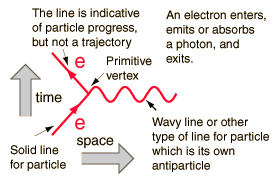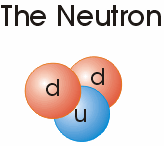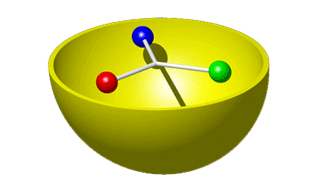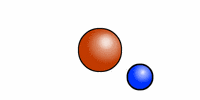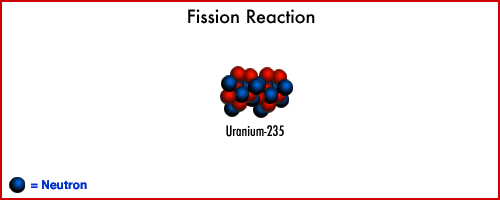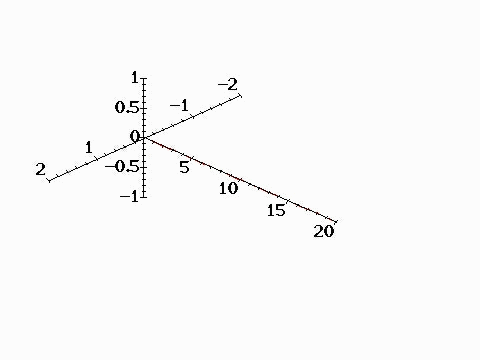Richard Feynman said, "There is room at the bottom."
![]()
Richard Feynman on the value puzzles.
The femto universe pictured below is very small.
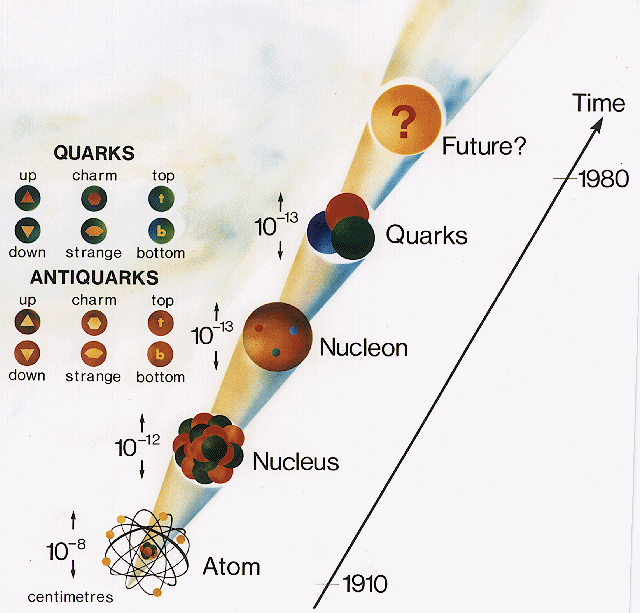 The Higgs boson, 4 July 2012. #1
The Higgs boson, 4 July 2012. #1
The relative size , the names, and the years when different sized particles were discovered.
"If you think you understand quantum theory . . . you don't understand quantum theory."
Attributed to Richard Feynman by R. Dawkins – The God Delusion, p. 365.
Quantum Mechanical View of Reality
.
The body of knowledge of quantum mechanics includes the governing rules of the Femto universe. That "universe" is at the bottom of the scale of sizes in material science. The objects about which rules can be observed, tested and used to construct new materials are very small and move at speeds close to that of light. Unlike planets and cannon balls the objects if this very, very small-sized cosmos (microcosm) do not behave according to predictions made by gravitational forces. Since they lack the mass required for gravitational forces to function, these objects are described by quantum mechanics. The theories that unite these observed patterns of interaction are called quantum theory.
"Any one who is not shocked by the quantum theory doesn't understand it."
Attributed to Niels Bohr by Michio Kaku –Visions, p. 265
Richard Feynman on Heisenberg's Uncertainty Principle, "not like classical particle physics."
| Material organization of the natural world | Meaning of the layers | |
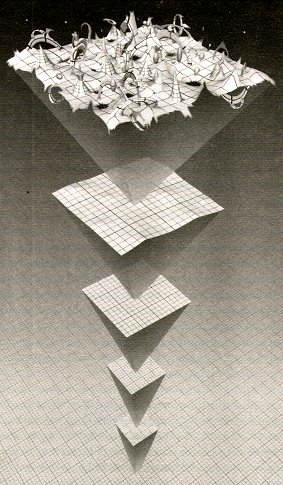 |
||
| Quantum foam at the femto level | ||
| Quarks | ||
| electrons, protons, neutrons, mesons. | ||
 |
||
| Atoms | ||
| Solids | ||
• Fact •
Every thirteen minutes [2] a stray neutron may decay into its binary pair [a proton with positive and an electron with negative charges] as a matter of entropy; when within an atomic nuclei, where neutrons outnumber protons we call this same statistical tendency: beta-decay.
We refer to these observed patterns of recurring behavior as predictive.
Science is, in part, knowledge of predictable behavior.
How? Any scientist measures repetitive patterns to describe these occurrences so that we understand enough of that behavior to predict the next event.
Science is thus one means to know our place in and the character of the material world.
"Scientists, therefore, are used to dealing with doubt and uncertainty. All scientific knowledge is uncertain. This experience with doubt and uncertainty is important. I believe that it is of very great value, and one that extends beyond the sciences. I believe that to solve any problem that has never been solved before, you have to leave the door to the unknown ajar. You have to permit the possibility that you do not have it exactly right. Otherwise, if you have made up your mind already, you might not solve it."
Richard Feynman, The Meaning of it All.
Knowledge of nature means:
"All the world is made of the same atoms."P. 12.
What
is science and its challenges to Feynman?
“In talking about the impact of ideas in one field on ideas in another field, one is always apt to make a fool of oneself.”
“In these days of specialization, there are too few people who have such
a deep understanding of two departments of our knowledge that they do not
make fools of themselves in one or the other.”
p. 3.
“There are great ideas developed in the history of man, and these ideas
do not last unless they are passed purposely and clearly from generation to
generation.”
“Problems of the development of science.”
“are not the kind that everyone appreciates.”
p. 4.
“it is not always a good idea to be too precise.”
pp. 4-5.
Science is:
1. “special method of finding things out"
2. a body of knowledge concerning what we have
discovered and accumulated over time.
3. meaning new things you can do when you have found
something out”
“This last field is usually called technology—but if you look at. . . “
p. 5.
“The most obvious characteristic of science is its application, . . .one
has power to do things.”
Eradication of sickness, slavery, insufficient quantities of food.
“are very likely the result of the development of scientific means of
production.”
p. 5.
“The product of this power is either good or evil.”
pp. 5-6.
Series of imbalances:
air & bacteriological war, automation, no disease
“The most famous of these imbalances is the development of nuclear energy and its obvious problems.”
p. 6.
“Is
science of any value?”
science is a key that opens the
thresholds of heaven and hell
Ibid.
“Now
this power to do things carries with it no instructions.”
p. 5.
“we do not have any instructions”
p. 7.
A theme of chapter one – repeated
“we cannot deny the value. . .”
“I think to say these are scientific problems is an exaggeration. They are far more humanitarian problems.
The
fact of how to work the power is clear, but how to control it is not, is not
so scientific and is not something a scientist knows much about.”
“very
exciting–everyone was going to help the underdeveloped countries. What
they needed of course was technical know how.”
A theme of chapter one – we possess a "can do" spirit -- that is to say Western faith in progress is based on one) the fact we can understand the world, and two) we can alter the world for a purpose.
p. 7.
For a photograph see: Rio de Janeiro, “La eterna problemática de las favelas --Por Rodrigo Mallea”
Rio’s favelas were without clean water and sanitation
“it is a pitiful thing.”
p. 8.
“Although we do not know how to solve the problem, ...we tried two things,
technical know how and economic assistance.”
p. 8.
A body of knowledge concerning what we have discovered and accumulated over time.
“That to keep trying new solutions is the way to do everything.”
p. 9.
“The next aspect of science is its contents, the things that have been
found out. This is the excitement"
“the
pay you get for al the disciplined thinking and hard work.”
“The work is not done for the sake of an application.”
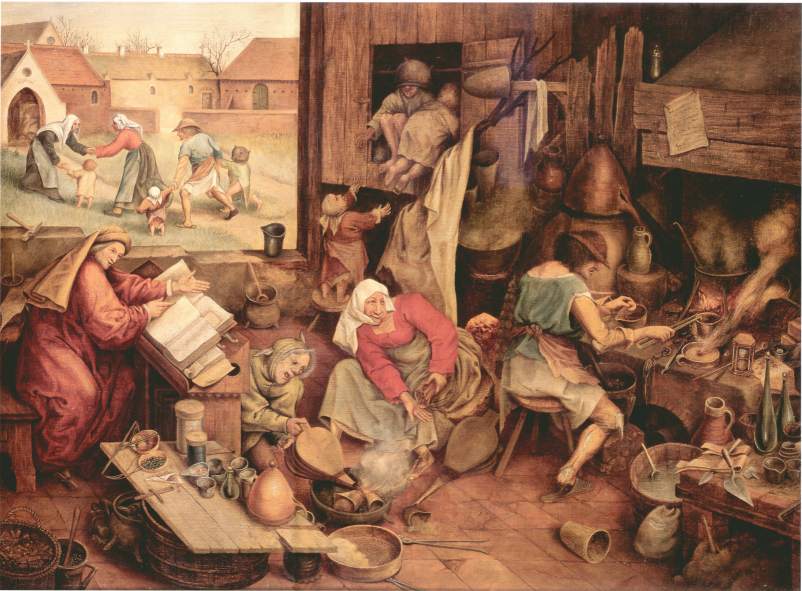
Pieter Brueghel the Elder, The Alchemist, c. 1558.
“unless you understand and appreciate the great adventure of our time.”
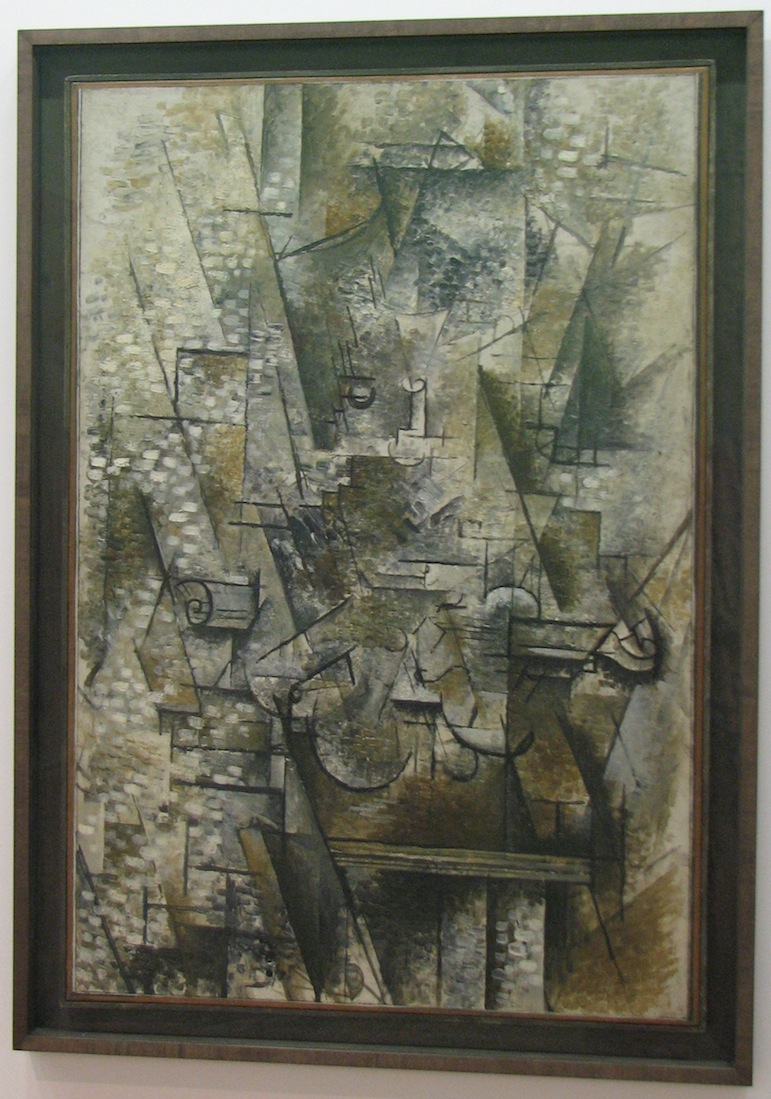 Georges Braque, "Still life" 1911.
Georges Braque, "Still life" 1911.
“You don't live in your time unless you understand that this is a tremendous adventure and a wild and exciting thing.”
p. 9.
“The force of gravitation.”
![]()
“Just as incomplete as the poetic pictures that came before.”
p. 10.
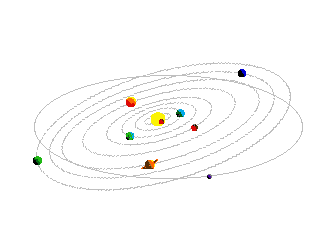
“But see the imagination of nature is far greater
than the imagination of man.”
“have some inkling of this through observations could ever have imagined
such a marvel as nature is.”
p. 10.
 “Can
you conceive, can you appreciate, or fit into your ideas what can be the meaning
of the world without a living thing on it?”
“Can
you conceive, can you appreciate, or fit into your ideas what can be the meaning
of the world without a living thing on it?”
“And in most places in the universe today there probably is nothing alive.”
p. 11.
The internal machinery of life “the chemistry of the parts is something
beautiful.”
Chlorophyll [shared by hemoglobin (reddish hue of iron)] benzene ring of carbon and nitrogen with magnesium [and greenish hue]
When a porphyrin molecule grabs a metal, it acquires different
properties and gets a different name. So, if the central metal is iron (Fe),
the porphyrin complex is called ferroporphyrin, or heme.
• Hemoglobin, the molecule in your red blood cells that grabs oxygen, has four of these heme groups. The iron ion of the heme group is responsible for binding the oxygen. The hemoglobin travels around the body, and when it reaches the tissues the iron in the porphyrin complex releases the oxygen to nourish them.
• Chlorophyll, the all-important molecule that allows plants to capture the sun's energy, and is responsible for plants' green color, is made up in part of a porphyrin molecule whose central metal ion is magnesium (M.G.). The vitamin B12 consists of a porphyrin molecule with a cobalt ion in the middle.
So, porphyrins are an extremely important group of organic compounds.
•• They are universal, found in most living cells of animals and plants, where they perform a wide variety of functions.
•• The iron in hemoglobin represents almost 70% of the total content in our body.
•• The iron in hemoglobin is coupled with porphyrin, and functional integrity of hemoglobin comes from the symmetric molecular structure of porphyrin.
Discovering the unity of all things
p.
11 – 12, 13-14, 15.
“or there are the atoms”
"That the stars are of the same stuff as ourselves."
p. 12.
and then electricity. The forces of attraction. . . we have a tremendous amount of machinery inside.
p. 13.
Faraday’s Chemical History of a Candle
pp. 13-14.
“suddenly
they were two aspects of the same thing–chemical changes with the results
of electrical forces.”
p. 15.
“trying
to understand the way nature works involves a most terrible test of human
reasoning ability.”
Beautiful
tightropes of logic . . . in predicting what will happen.”
“The
quantum mechanical and the relativity ideas are example of this.”
The
third aspect of my subject is that of science as a method of finding things
out.
This
method is based on the principle that observation It is the judge of whether
something is or is not.”
“Observation is the ultimate and final judge of the truth of an idea.”

“prove really means test.”
‘the exception tests the rule.”
Page, 15.
Similar mistakes in judgment:
"Even on the lowest level such errors are unnecessary today.
18.
"The more specific the rule is, the more interesting it is."
p. 19.
Boyle's law of gas pressures:
A great question of authority:
"We have lost the need to go to an authority."
21.
It is not understood at all, but it leads to the possibility of prediction . . .it tells you what you would expect to happen in an experiment you have not yet done."
"and the rules, at least in physics, become reduced."
page 23.
"The beautiful prediction of the rules in chemistry and electricity into one rule."
24
“This freedom to doubt is an important matter in the sciences
p. 28.
“It was a struggle to be permitted to doubt, to be unsure.”
Richard P. Feynman, The Meaning of It All: Thoughts of a Citizen-Scientist. (1998)
Three facets of Science
Galileo Galilei | Murray Gell-Mann | Jacob Bronowski | Stephen Hawking | Ernst Mayr | Ian Tattersall | Charles Darwin
We are going to study nature by exploring the "microcosm" at smaller and smaller distance scales; that is natural matter at the subatomic scale.
The Discovery of the Higgs Boson.
What is the Higgs boson and the Higgs field?
The Higgs boson and field answer the question: Where does the mass of elementary particles come from? The Higgs field permeates all of space and as particles move through the field different particles absorb or at least acquire the massive measure. (the aether?)
The sub-atomic particles attain their mass from the Higgs environment which is ubiquitous [that is to say everywhere around us], but discovering the Higgs field & Higgs boson is like hearing a whisper in a symphony; the symphony that is the light quantum of the universe.
"the elementary particles that have been discovered at the tiniest scales ever explored."
[2] 12 minutes and 30 seconds or two every 25 minutes – or from 10.5 to 18 minutes.
